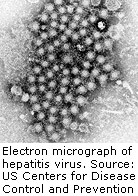Prevalence of chronic HBV infection constant at 0.3 percent since 1999 despite rising immune protection
WEDNESDAY, Aug. 12, 2015 (HealthDay News) — The prevalence of chronic hepatitis B virus (HBV) infection has remained constant since 1999, according to a study published online Aug. 6 in Hepatology.
Henry Roberts, Ph.D., from the U.S. Centers for Disease Control and Prevention in Atlanta, and colleagues sought to determine the prevalence of HBV infection among non-institutionalized individuals aged 6 years and older. They examined the prevalence of antibody to hepatitis B core antigen (anti-HBc), hepatitis B surface antigen, and antibody to hepatitis B surface antigen over three periods: 1988 to 1994, 1999 to 2009, and 2007 to 2012.
The researchers found that for 2007 to 2012, 3.9 percent had anti-HBc. Since 1999, the overall prevalence of chronic HBV infection remained constant at 0.3 percent; the prevalence among non-Hispanic blacks was two- to three-fold greater than that seen in the general population. During 2011 to 2012, an estimated 3.1 percent of non-Hispanic Asians were chronically infected with HBV. Since 1999, there was a 16 percent increase in the adjusted prevalence of vaccine-induced immunity, and there was an increase in the number of persons, mainly young, with serologic evidence of vaccine protection from HBV infection, from 57.8 to 68.5 million.
“Despite increasing immune protection in young persons vaccinated in infancy, an analysis of chronic hepatitis B prevalence in racial and ethnic populations indicates that during 2011 to 2012 there were 847,000 HBV infections (which included ~400,000 non-Hispanic Asians) in the non-institutionalized U.S. population,” the authors write.
Copyright © 2015 HealthDay. All rights reserved.








